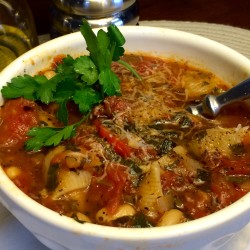Tuesday, October 11, 2011
Forget store-bought broth with its heaps of sodium and excess packaging: use your veggie and herb scraps in this easy DIY vegetable stock. Better for you and the planet too.
STOP! Don’t toss those peels, carrot tops, and other veggie scraps into the garbage disposal or compost pile just yet. What you have here, along with some water, herbs, and a few other ingredients, is the makings of a homemade vegetable stock. And that, my friends, is the beginning of great soup.
It could not be easier, as you’ll see in the following introductory video clip. (The longer version showing all the steps is here.) But first, here are a few good reasons why you should make your own veggie stock:
It basically costs you pennies. You are using mostly veggie scraps you would have otherwise discarded, along with water and a few other ingredients you probably have lying around. Or, they are very inexpensive to buy and you’ll use them in other things.
It’s a great way to extricate every last nutrient from your veggies. Remember, you would have otherwise discarded what you thought was veggie detritus. Instead, you are flavoring water for a stock. A very efficient way to use up all parts of your veggies, indeed.
It reduces your waste, hence the carbon footprint of your meal. Stocks (or broths) come in cans or boxes, and other soup starters like bouillon come in a variety of other packages like envelopes and jars. We can avoid all of that by making our own. Even if we are able to recycle the packaging, reducing consumption is the starting place for sustainability.
It’s ridiculously quick and easy. Bring water with various veggie scraps up to boil, simmer for 30 minutes to an hour (no longer), strain, then use, refrigerate, or freeze. Check out the brief intro video below.
It’s generally much better for you. Let’s get quantitative.

For more details on making stock, beginning to end, click here.
And guess what? If you are prepping vegetables for another dish you can store your scraps in a plastic bag in the freezer for a day when you do feel like making stock. I always have a bag in there for just this purpose. This makes the preparation of homemade veggie stock even that much quicker, bringing you one step closer to a steaming bowl of homemade soup one cold autumn day.
Supplemental video notes
Just a reminder to make sure your veggies have been washed. I know you know that, but don’t forget you need to wash the entire garlic cloves and onions if you plan to use the peels. You don’t want dirt in your stock. And if you do use the peels and skins, I’d also try to use organic vegetables. (This is something you should always try to do, anyway – a topic for another day.)
Add some onions (or scallions) along with some chunks of whole carrots and celery. (Cut 2 or so carrots and celery into 2 inch chunks or so, and quarter 1 onion or use 4-5 whole scallions.) Here’s a tip: when I’m cutting off the tops of the carrots (whether the stubby ends or the green tops) or the ends of the onion that I won’t use in cooking, I throw them all in that plastic freezer bag. Then you don’t even need to use whole veggies because you have scraps ready to go. You can also add whole cloves of garlic, but peel them first to increase the permeability of the flavors into the water. Or, you can just smash them in their skins and drop the whole thing in there.
Finally, the note about tomatoes. Tomatoes are very high in water and have lots of seeds. They basically just disintegrate into the stock and even though you can strain the seeds out later they tend to impart a distinct flavor that I don’t always want. I like to create a stock that I can use as a flexible base and then add specific ingredients and flavors when making the soup itself. Also, part of the appeal for me is to use the parts of the veggies I wouldn’t otherwise eat; I use all parts of the tomato. All that said, there are lots of recipes for vegetable stock out there and I’ll bet people have different opinions on this. I can tell you my vegetable stock recipe is a tasty base for any soup, but try making up a batch of your own and see what works for you!
—
Learn more about nutrition scientist and food personality Dr. P.K. Newby, and check out her newest book. You can also follow her on FB, where she is much more active than on this blog. Or, click here if you just want to ogle food porn featuring plant-based, globally-inspired cuisine.





Wow you make that look really easy. I usually make homemade bouillon which is a lot of chopping, cleaning and processing, but it takes up much less space in your fridge. In fact you freeze it.
But again that looks quite simple, especially if it only takes 30 minutes or so. Would you recommend using pasta water as a base for soup stock?
Homemade bouillon! I’m so impressed, Matthew!!! (And thanks for visiting my blog 🙂 ). I think stock sounds like it’s way easier, yes. Do tell me how – or, better yet, maybe post on my FB page for more people to see. I’ll actually be reposting this video there in the next couple of weeks. Taking up less space would be a huge bonus because my freezer is always packed! I love it! Re. pasta water … hmmm. It’s an interesting idea. There’s starch in there (as you know) so that will add some viscosity and would also impact the flavors so I’m not sure. I’d probably keep with plain water but sounds like a worthwhile experiment ;). And, yes, general recipes for veggie stock keep them to simmering for no more than an hour as bitter flavors can be imparted if they continue for much longer. I’ve found ~45 minutes or so works best. Tasting, as always, is key…